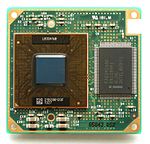Notebook processor
The notebook processor , also known as a mobile processor , is a subtype of processors (CPUs) that are mainly installed in mobile and particularly energy-saving computer systems.
General
Technologically Notebook processors usually come from the cores of desktop processors, like the Intel - Pentium family, the AMD - Athlon family or PowerPC from. However, due to special selection during production, only chips are used that can work with a lower core voltage ( ) than normal processors. In addition, functions are activated with which the processor speed can be adapted to the current performance requirements of the system and the user. Furthermore, the core tension becomes dynamic and extremely fast, e.g. B. between two keystrokes, shut down, which further lowers the power consumption, since the power loss increases quadratically to the core voltage. At Intel this technology is called (enhanced) SpeedStep , at AMD PowerNow! (Similar technology with desktop CPUs called Cool'n'Quiet ), with Transmeta Longrun or Longrun 2 and with VIA LongHaul or PowerSaver . These systems reduce the power consumption in the idle state , also in idle mode, and extend the battery life of the notebooks considerably. Due to these features and increased production costs, these processors are usually considerably more expensive than desktop processors with the same or higher clock rates.
Differences to the embedded CPU
Unlike embedded CPUs, notebook processors have enough computing power for modern computer systems and multimedia and productivity applications (e.g. video editing or office applications). However, some models are used because of their greater capabilities. B. installed in large industrial control systems and cash register systems.
In contrast to notebook processors, embedded CPUs are usually not x86 or PowerPC models, but are based on architectures such as MIPS or ARM . They are installed in consumer electronics devices such as set-top boxes or PDAs .
Use in other systems
Because of their low power loss and because of the tough price war among CPU manufacturers, they are now quite affordable, notebook processors are sometimes built into desktop systems. Despite the low power consumption, this is associated with high costs, since the acquisition costs for such systems are approx. 20–30% higher and this is usually not amortized over a typical "computer life" with lower power consumption alone. The lower background noise due to the lower cooling requirements of such systems can be seen as an advantage.
In the server sector, notebook processors are often used in blade servers because the cooling effort is greatly reduced. In large data centers, supercomputers and other large computing clusters, cooling can account for over 30% of total energy requirements. The packing density and thus the computing power per rack can also be increased. Both lead to greater cost advantages than with desktop systems, since servers usually run under full load more often and professional server hardware is naturally more expensive.
variants
Notebook processors are divided into different classes, some of which differ greatly in terms of power consumption and performance.
For some time, the much cheaper desktop processors with the same performance were installed. Today this only happens in isolated cases, as the few desktop processors that actually offer a performance advantage have a power consumption that is far in excess of 100 W. The battery life in such systems is extremely short, if a battery is installed at all, so that they are only suitable as desktop replacement .
Most of the processors in simpler notebooks today are processor families that were only developed for use in notebooks and are equipped with special power-saving functions and greatly reduced voltages and thus usually consume between 25 and 40 W. Low-voltage processors (LV) and ultra-low-voltage processors are used in very small notebooks . Although these are basically based on normal notebook processors, they are even more radically optimized at the expense of performance to a low power consumption of less than 10 W.



